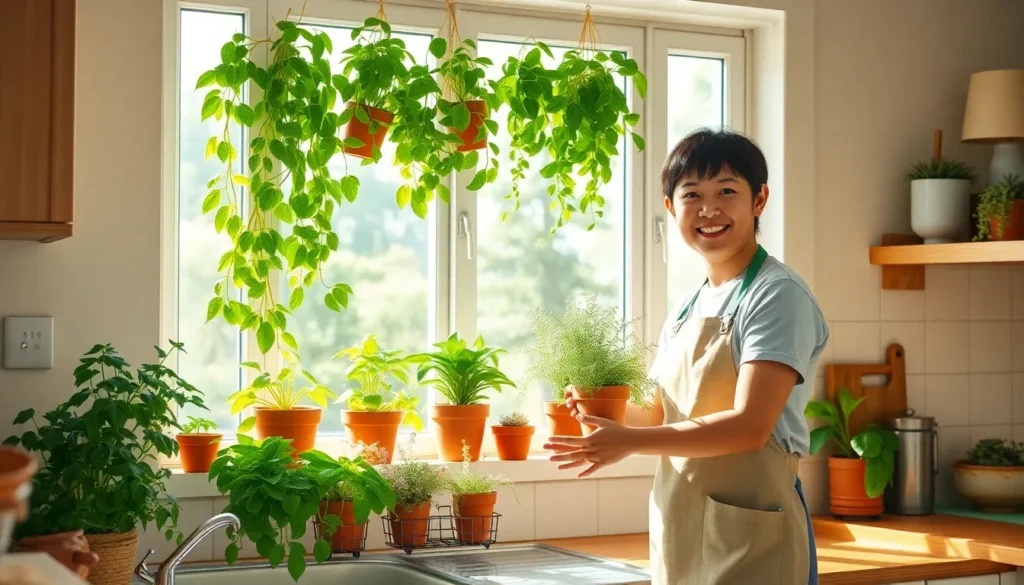We’ve all dreamed of that picture-perfect kitchen where fresh herbs cascade from windowsills and vibrant greens add life to every corner. Kitchen plants aren’t just Instagram-worthy décor – they’re game-changers that transform your cooking space into a thriving network of flavor and functionality.
The best part? You don’t need a green thumb or acres of counter space to create your own indoor kitchen garden. From compact herb collections that’ll revolutionize your weeknight dinners to air-purifying powerhouses that keep your cooking environment fresh we’ll show you exactly which plants thrive in kitchen conditions.
Whether you’re dealing with limited natural light steamy cooking conditions or minimal space we’ve discovered the perfect plant answers that’ll turn your kitchen into both a culinary haven and a green sanctuary. Ready to discover which plants will transform your cooking experience forever?
Best Low-Light Plants in the Kitchen for Beginner Gardeners
Kitchen spaces often lack abundant natural light, but that doesn’t mean we can’t enjoy thriving plants. These resilient varieties flourish in dimmer conditions while requiring minimal care from novice gardeners.
Snake Plants for Dark Corners
Snake plants excel in the shadiest kitchen corners where other plants struggle to survive. We’ve found these architectural beauties can thrive with as little as 50 foot candles of light, making them perfect for spaces near pantries or interior walls. Their thick, sword shaped leaves store water efficiently, meaning we only need to water them every 2-3 weeks.
These plants naturally purify kitchen air by removing formaldehyde and benzene toxins commonly found near cooking areas. Snake plants grow slowly, reaching 2-4 feet tall, which makes them ideal for floor placement beside refrigerators or in unused corners. Their tolerance for neglect means busy home cooks won’t stress about daily plant care routines.
Pothos Vines for Cabinet Tops
Pothos vines transform empty cabinet tops into cascading green displays that soften harsh kitchen lines. We love how these trailing plants adapt to fluorescent lighting and can grow over 10 feet long when given proper support. Their heart shaped leaves remain vibrant even when placed 6-8 feet from windows.
These fast growing vines root easily in water, allowing us to propagate new plants from cuttings within 2-3 weeks. Pothos plants indicate their watering needs clearly through slightly drooping leaves, making it simple for beginners to establish proper care schedules. We recommend golden pothos varieties for kitchens since their variegated leaves add visual interest above cooking spaces.
Cabinet mounted pothos create natural privacy screens between kitchen and dining areas while requiring water only once weekly. Their ability to climb or trail makes them versatile for various kitchen layouts and storage configurations.
ZZ Plants for Minimal Maintenance
ZZ plants require the least attention among kitchen suitable varieties, making them perfect for gardening newcomers. We appreciate how these glossy leaved plants can survive in lighting as low as 25 foot candles while maintaining their deep green color. Their underground rhizomes store months worth of water and nutrients.
These drought tolerant plants need watering only every 3-4 weeks, even in warm kitchen environments. ZZ plants grow 2-3 feet tall with a compact spread that fits perfectly on kitchen islands or counter ends. Their waxy leaves naturally repel dust and cooking residue, staying clean with minimal wiping.
We’ve observed ZZ plants continue growing steadily even when placed far from windows or under cabinet lighting. Their tolerance for temperature fluctuations makes them ideal near stoves, dishwashers, and other heat producing kitchen appliances.
Essential Herb Gardens to Grow Plants in the Kitchen
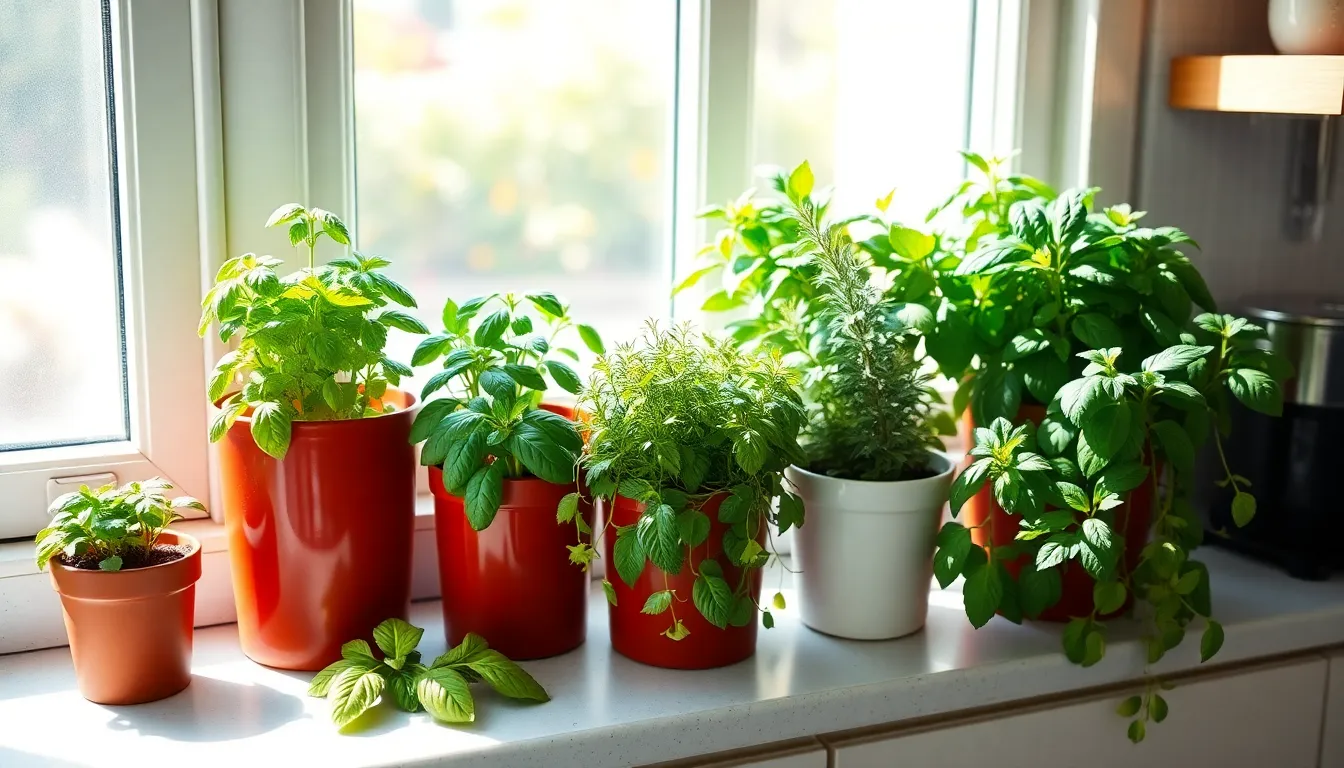
Moving beyond ornamental plants, we can transform our kitchen into a functional herb garden that enhances our cooking while maintaining that vibrant greenery. These culinary herbs offer both practical benefits and aromatic beauty for our indoor space.
Basil for Fresh Italian Cooking
Basil thrives exceptionally well on sunny kitchen windowsills where it receives adequate sunlight throughout the day. We recommend keeping the soil moist but well-drained, watering regularly to maintain optimal growing conditions. Fresh basil leaves elevate Italian dishes like pesto, tomato sauces, and salads with their distinctive aromatic flavor.
Growing basil indoors proves incredibly rewarding since we can harvest leaves continuously for immediate use in our cooking. The herb’s fragrant presence adds natural aromatherapy to our kitchen environment. Regular harvesting actually encourages new growth, ensuring we’ll have fresh basil available year-round for our favorite recipes.
Mint for Teas and Cocktails
Mint stands out as one of the hardiest, low-maintenance herbs perfect for our kitchen gardens. We can easily propagate mint from cuttings by placing them in water until roots develop before transferring to soil. This versatile herb adapts well to partial shade or full sun conditions while preferring consistently moist soil.
Multiple varieties offer unique flavors including spearmint, peppermint, and chocolate mint for different culinary applications. We should space different mint varieties apart to preserve their distinct aromas and prevent cross-contamination. Fresh mint leaves enhance teas, cocktails like mojitos, and serve as beautiful garnishes for various dishes throughout the year.
Rosemary for Year-Round Seasoning
Rosemary proves to be a resilient perennial herb that adapts well to indoor growing with full sun exposure. We need to water this herb less frequently than basil or mint, allowing the well-drained soil to dry between waterings to prevent root rot. The robust, pine-like flavor complements meats, soups, and stews perfectly throughout all seasons.
Continuous harvesting becomes possible once our rosemary plant matures, providing fresh seasoning whenever we need it. This hardy herb tolerates neglect better than most kitchen plants, making it ideal for busy home cooks. Rosemary’s evergreen nature ensures we’ll have access to fresh herbs even during winter months when outdoor gardening isn’t possible.
Strategic Placement Ideas for Plants in the Kitchen
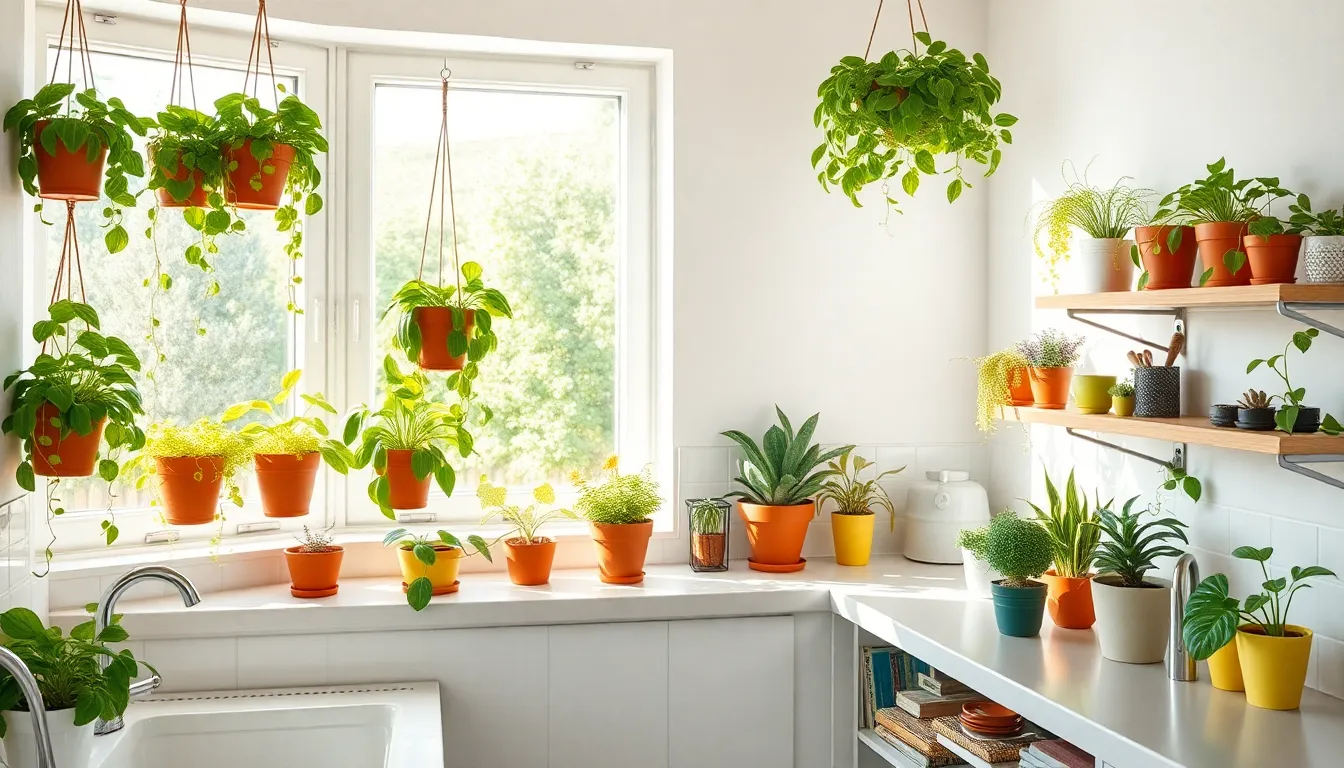
Now that we’ve covered ideal plant varieties, let’s explore how to position them strategically throughout your kitchen space for maximum health and visual impact.
Window Sill Gardens for Maximum Sunlight
Window sills offer the perfect foundation for thriving kitchen gardens by providing essential natural sunlight that plants crave. We recommend positioning herbs like basil and thyme directly on sunny window sills where they’ll receive optimal light conditions for healthy growth. Small vegetables such as tomatoes also flourish in these bright spots, creating accessible mini gardens right at your fingertips.
Creating vibrant green corners on sunny shelves transforms your kitchen atmosphere while keeping plants within easy reach for daily cooking needs. Placing plants in these prime sunlight locations ensures they receive the energy necessary for robust development and continuous harvests.
Hanging Planters Above Kitchen Islands
Hanging planters above kitchen islands present creative answers for adding greenery without sacrificing valuable counter space. We suggest installing hanging pots with trailing plants like pothos or ivy to create stunning visual displays that enhance your kitchen’s natural appeal. These elevated gardens add vertical interest while drawing the eye upward, making your kitchen feel more spacious and alive.
Vertical wall gardens on free walls offer additional opportunities to maximize growing space in compact kitchens. Suspending plants keeps them safely away from heat sources like stoves, protecting their health while maintaining easy access for watering and harvesting.
Counter Space Arrangements for Easy Access
Counter arrangements near sinks provide convenient watering access, especially beneficial for plants requiring frequent hydration. We position high maintenance plants close to water sources while placing drought tolerant varieties in less accessible spots to encourage proper watering schedules. This strategic placement helps prevent both overwatering and underwatering issues.
Grouping plants in odd numbers like threes creates naturally harmonious displays on counters and shelves that feel balanced and intentional. Keep plants away from stoves and other heat sources since high temperatures can damage foliage and stress root systems. Varying pot colors and sizes adds personality while maintaining functional accessibility throughout your daily cooking routines.
Air-Purifying Plants in the Kitchen That Remove Toxins
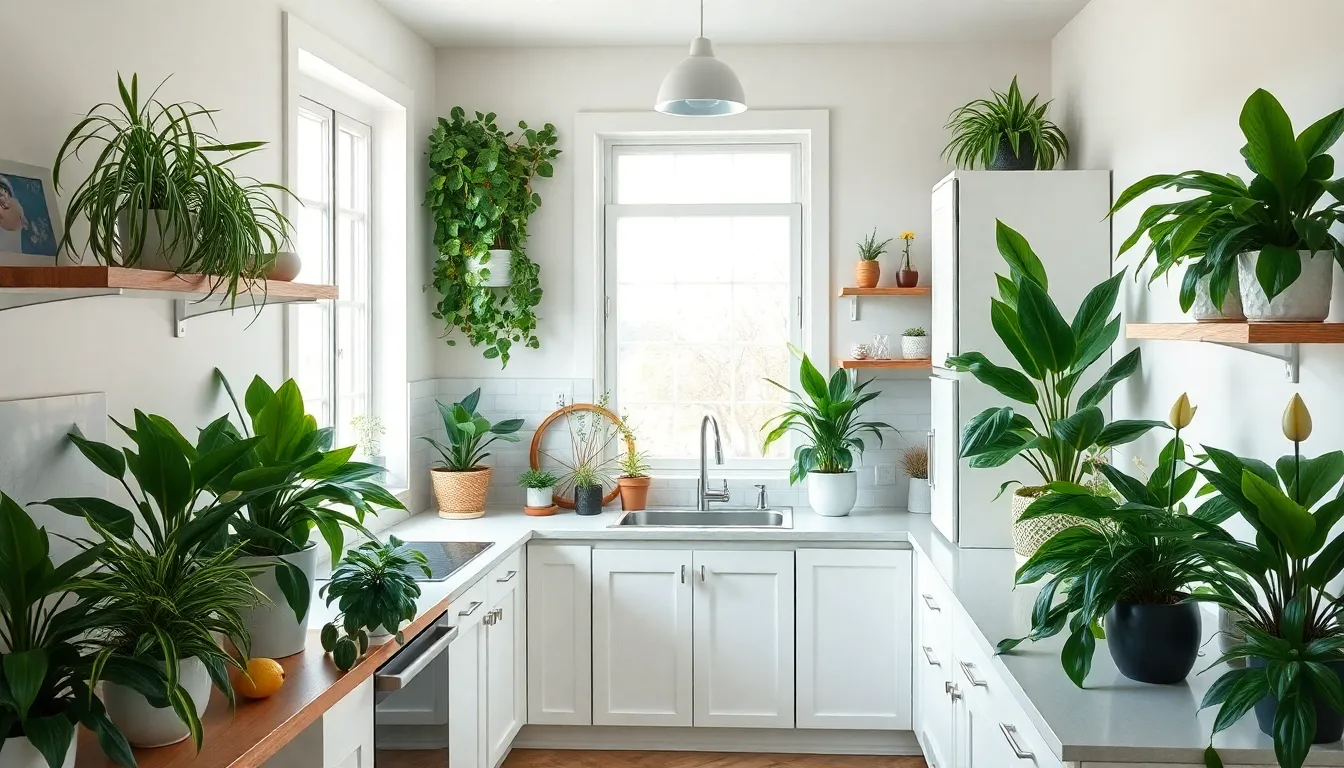
Beyond adding beauty to our culinary spaces, certain plants actively work to clean the air we breathe while we cook. NASA research has identified exact plants that excel at removing common kitchen toxins like formaldehyde, benzene, and ammonia from indoor environments.
Spider Plants for Formaldehyde Removal
Spider plants (Chlorophytum comosum) efficiently remove formaldehyde, a chemical frequently emitted by synthetic materials and cleaning products we commonly use in our kitchens. These resilient plants thrive in indirect sunlight, making them perfect for placement away from our cooking areas while still providing air purification benefits.
Caring for spider plants requires minimal effort since they tolerate a wide range of temperatures and lighting conditions. We can place them on top of our refrigerators or in corners where they’ll receive gentle, filtered light throughout the day.
Propagating spider plants creates multiple air purifiers as they naturally produce small plantlets that we can easily root in water and transplant. This characteristic allows us to expand our kitchen’s air purification capacity without additional plant purchases.
Rubber Trees for Chemical Filtration
Rubber trees (Ficus elastica) filter multiple chemicals through their large leaves and robust root systems, making them powerful allies in maintaining clean kitchen air. Their substantial leaf surface area captures and processes various indoor pollutants more effectively than smaller plants.
Positioning rubber trees in corners or near dining areas allows them to work continuously without interfering with our cooking activities. These plants prefer bright, indirect light and can grow quite tall, creating impressive focal points in our kitchen spaces.
Maintaining rubber trees involves regular leaf cleaning to maximize their air purification efficiency. We should wipe their glossy leaves weekly with a damp cloth to remove dust and ensure optimal toxin absorption through their leaf surfaces.
Peace Lilies for Humidity Control
Peace lilies (Spathiphyllum) remove five different toxins including formaldehyde, benzene, trichloroethylene, xylene, and ammonia from our kitchen air. Their broad leaves and active transpiration process simultaneously filter harmful chemicals while adding beneficial moisture to dry indoor environments.
Humidity regulation makes peace lilies especially valuable in kitchens where moisture levels fluctuate dramatically during cooking activities. These plants help stabilize air moisture, creating more comfortable breathing conditions while we prepare meals.
Growing peace lilies succeeds in indirect light conditions commonly found in kitchen areas away from windows. We need to keep their soil consistently moist and watch for their distinctive drooping signal when they need water, making them relatively straightforward to maintain alongside our cooking routines.
Compact Vegetable Plants in the Kitchen for Small Spaces
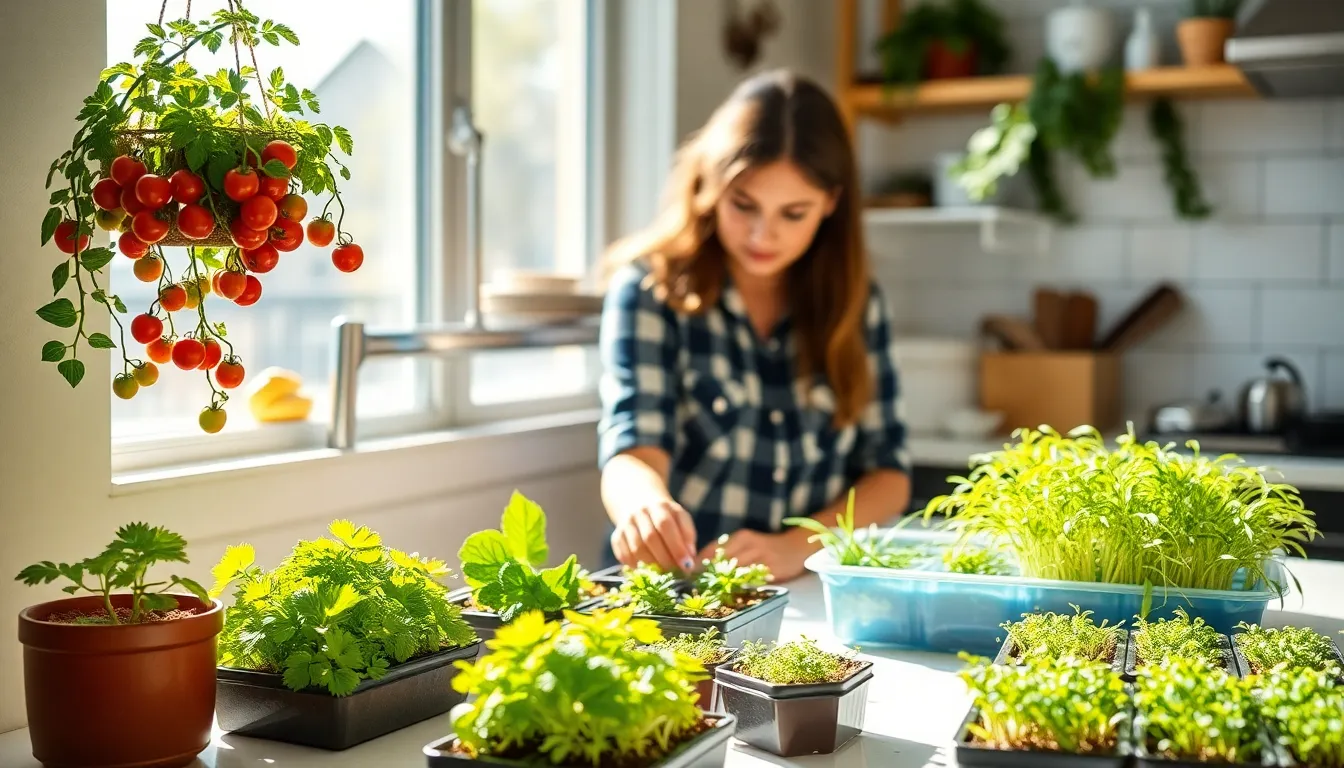
Growing fresh vegetables in your kitchen doesn’t require a sprawling garden or extensive space. We can maximize small kitchen areas with carefully selected compact vegetable varieties that thrive indoors and provide fresh produce year-round.
Cherry Tomatoes in Hanging Baskets
Cherry tomato varieties like “Tiny Tim” offer the perfect solution for vertical growing in small kitchens. These compact plants grow approximately 12 inches tall and produce abundant fruit in containers or hanging baskets. We recommend placing them in sunny kitchen windows that receive 6+ hours of direct sunlight daily, or supplementing with grow lights for optimal growth.
Hanging baskets create an efficient use of vertical space while keeping your counters clear for cooking. The cascading growth pattern adds visual appeal to your kitchen while providing easy access to fresh tomatoes. These varieties require regular watering and good drainage to prevent root rot in container environments.
Lettuce Varieties in Shallow Containers
Miniature lettuce varieties such as “Tom Thumb” mature at just 4 to 5 inches tall, making them ideal for shallow containers on windowsills. These compact greens require minimal soil depth and can thrive in containers as shallow as 6 inches. We find that these varieties grow well with moderate sunlight and are exceptionally easy to maintain in small kitchen spaces.
Harvesting becomes incredibly convenient when lettuce grows within arm’s reach of your food preparation area. The continuous harvest method allows us to pick outer leaves while the center continues growing, providing fresh salad greens for weeks. These varieties adapt well to indoor conditions and require consistent moisture without waterlogging.
Microgreens on Kitchen Counters
Microgreens represent the most space efficient option for fresh produce in compact kitchens. These nutrient dense plants grow in small trays directly on kitchen counters without requiring deep soil or extensive root systems. We can harvest microgreens in as little as 1 to 3 weeks from planting, making them perfect for quick turnaround crops.
Growing microgreens requires minimal equipment and provides maximum nutrition in the smallest footprint possible. The shallow growing trays fit easily on countertops and require only moderate light conditions to thrive. These fast growing plants offer concentrated flavors and nutrients that enhance our cooking while taking up minimal kitchen real estate.
Proper Care Tips for Plants in the Kitchen Environment
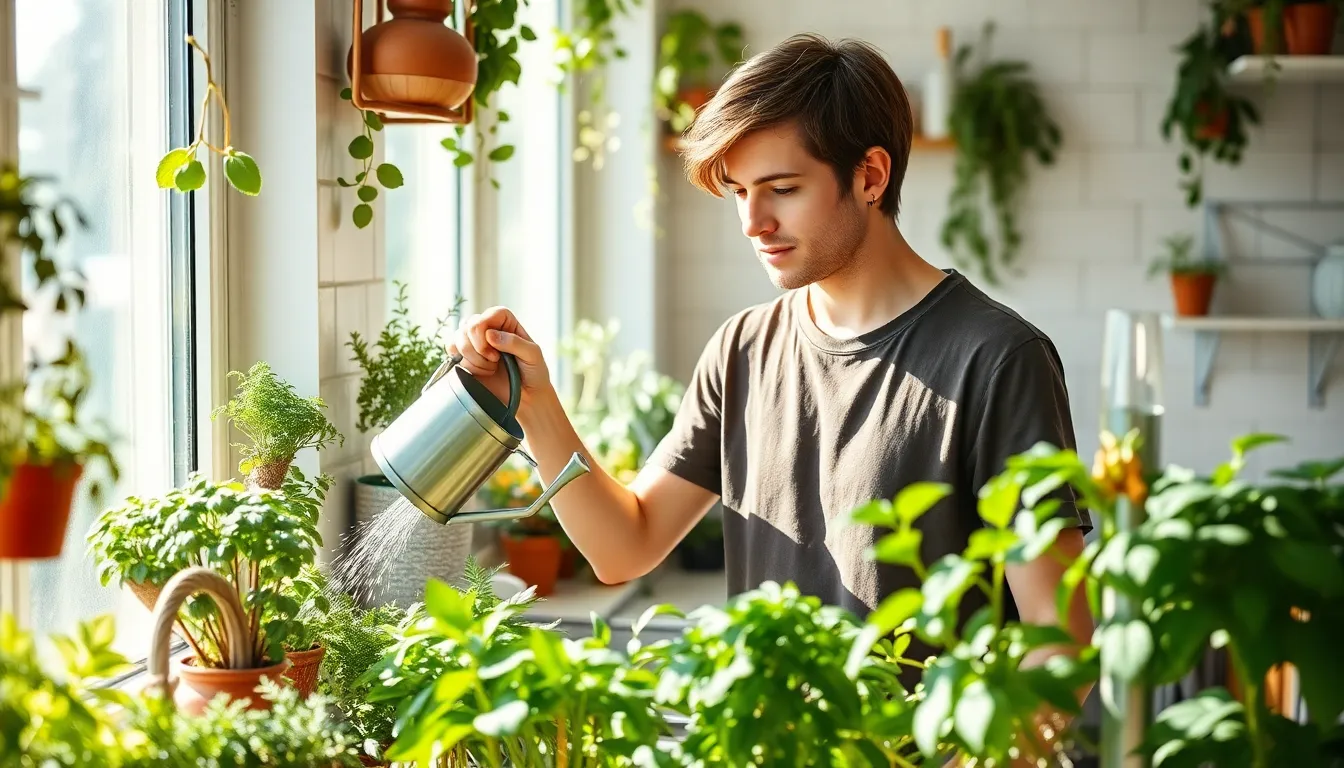
Maintaining healthy plants in your kitchen requires understanding how cooking activities affect their growing conditions. We’ll show you how to adapt your plant care routine to work seamlessly with your daily kitchen activities.
Watering Schedules Around Cooking Activities
Balance moisture levels by keeping soil consistently moist but never soggy throughout your cooking routine. We recommend letting the soil dry out slightly between waterings to prevent overwatering, which causes yellow leaves and plant stress.
Save cooled pasta water from your cooking sessions to nourish your kitchen plants with beneficial nutrients. This simple practice transforms kitchen waste into plant food while reducing water waste in your home.
Reduce watering frequency by approximately half during winter months when plant growth naturally slows down. We’ve found this adjustment prevents root rot while supporting healthy dormancy periods until spring growth resumes.
Check soil moisture before each watering session by inserting your finger one inch deep into the potting mix. This hands-on approach ensures you’re providing exactly what your plants need without guessing.
Managing Humidity from Steam and Heat
Use cooking steam to naturally increase humidity levels around your kitchen plants, as most varieties thrive in moderate moisture conditions. We position plants strategically to benefit from this natural humidity boost during meal preparation.
Keep plants away from direct heat sources like ovens and stovetops that can quickly dry out foliage or cause permanent damage. Safe distances of at least three feet protect your plants from temperature fluctuations while maintaining kitchen functionality.
Promote air circulation throughout your kitchen space to prevent fungal diseases that develop in overly humid, stagnant conditions. We recommend using ceiling fans or opening windows periodically to maintain healthy airflow.
Monitor temperature zones in different areas of your kitchen to identify the most stable locations for plant placement. Consistent temperatures between 65-75°F create optimal growing conditions away from cooking heat sources.
Fertilizing Indoor Kitchen Plants
Apply balanced houseplant fertilizer occasionally during active growing seasons in spring and summer when plants show new growth. We use diluted liquid fertilizers every 4-6 weeks to support healthy foliage development without overwhelming root systems.
Avoid fertilizing completely during winter dormancy periods when plant growth naturally slows down and nutrient uptake decreases. This practice prevents fertilizer burn and allows plants to rest properly before spring growth resumes.
Choose organic options like compost tea or fish emulsion that provide gentle, slow-release nutrients perfect for culinary herbs and edible plants. These natural fertilizers support robust flavor development in herbs while maintaining food safety standards.
Watch for signs of over-fertilization including burnt leaf edges, excessive foliage growth, or reduced flowering in herb plants. We adjust feeding schedules based on individual plant responses rather than following rigid schedules.
Creative Container Ideas for Plants in the Kitchen Decor
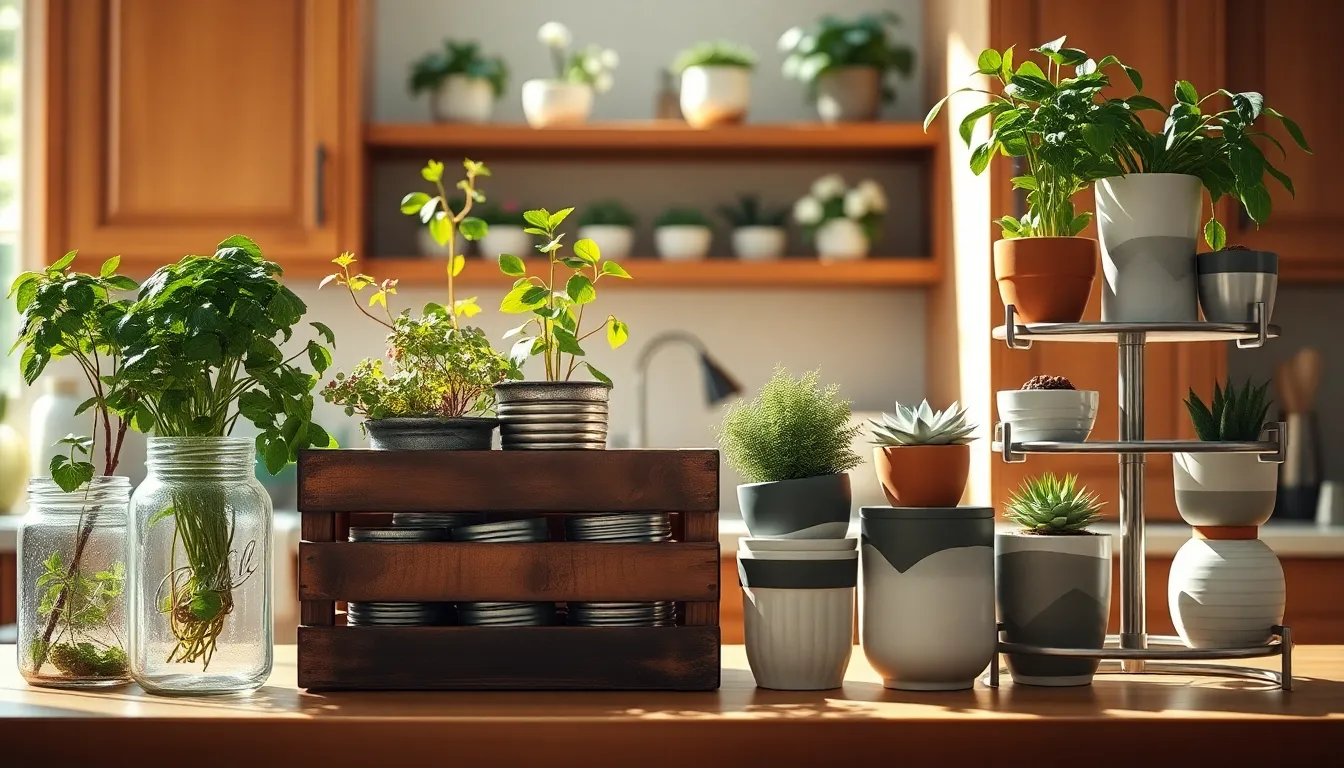
We’ve covered the basics of plant care and placement, but choosing the right containers can truly elevate your kitchen’s aesthetic while maximizing functionality. Creative containers transform ordinary plants into stunning decor elements that complement your cooking space.
Repurposed Mason Jars and Bottles
Mason jars create perfect homes for small herbs or succulents while adding rustic charm to any kitchen design. We love how these versatile containers can be hung from hooks, arranged on floating shelves, or clustered together on windowsills to save precious counter space. Glass bottles work equally well for propagating herb cuttings like mint or basil, letting you watch roots develop while creating living art displays.
Grouping three or five mason jars together creates visual balance while showcasing different herbs like oregano, thyme, and parsley. Clear glass allows natural light to reach plant roots while letting you monitor water levels at a peek. These budget friendly options cost less than traditional planters while delivering that coveted farmhouse aesthetic.
Wooden Crates and Vintage Tins
Wooden crates provide warm, natural elements that beautifully complement existing kitchen woodwork and cabinetry. We recommend using them as multi plant holders or lining them with plastic to create custom planters for larger herb collections. Small vintage crates work perfectly on open shelving while larger ones can house multiple plants on kitchen islands or counter corners.
Vintage tins add nostalgic character while serving practical purposes for compact herb gardens. Coffee tins, tea containers, and old biscuit boxes create conversation pieces that blend function with personality. These containers work exceptionally well for plants like chives, cilantro, or small pepper plants that don’t require deep root space.
Both options develop beautiful patina over time, making them more attractive as they age in your kitchen environment.
Modern Ceramic Planters and Stands
Ceramic planters deliver contemporary elegance while offering superior moisture retention for healthier plant growth. We particularly appreciate fluted stoneware pots paired with pine wood bases, which provide minimalist warmth without overwhelming modern kitchen designs. These elevated containers keep plants off counters while creating organized, sophisticated presentations.
Plant stands with multiple tiers maximize vertical space by positioning frequently used herbs on top levels for easy access during cooking. Lower shelves accommodate storage for cookbooks or kitchen tools, making these stands both functional and space efficient. White or neutral ceramic colors complement any kitchen color scheme while drawing attention to the vibrant greens of your plants.
Matching sets of ceramic planters create cohesive looks across windowsills or countertops, while mixing sizes adds visual interest without appearing cluttered.
Common Mistakes to Avoid with Plants in the Kitchen
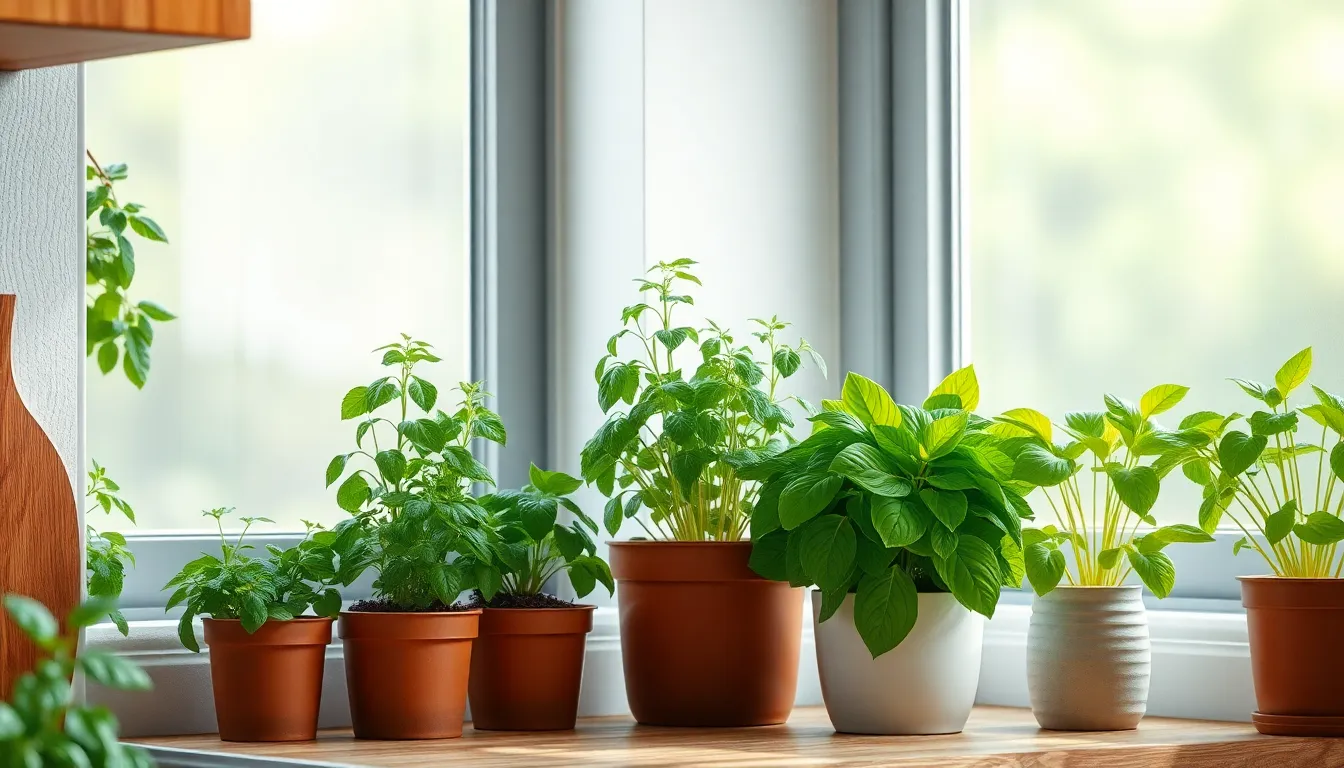
We’ve covered the essentials of growing plants in your kitchen, but even experienced gardeners can fall into common traps. Understanding these mistakes will help you maintain thriving plants that enhance your cooking space.
Overwatering from Kitchen Sink Proximity
Overwatering becomes a serious threat when we place plants too close to our kitchen sink. Easy access to water creates the temptation to water more frequently than necessary, while accidental spills can saturate soil without us realizing it. Root rot develops quickly in these conditions and often proves fatal to houseplants.
Check soil moisture before watering by inserting your finger about an inch deep into the soil. Water only when the soil feels dry to the touch, not when it’s still moist. Room temperature water works best for plant roots, especially in cooler kitchen environments. Proper drainage holes in containers prevent waterlogging that leads to soggy soil conditions.
Choosing Wrong Plants for Kitchen Conditions
Kitchen environments present unique challenges with varying light levels, humidity, and temperature fluctuations. Selecting plants that don’t match these exact conditions results in poor growth or complete plant failure. Sun loving plants will struggle in kitchens with limited natural light, while low light tolerant species thrive in dimmer conditions.
Match plants to your kitchen’s actual conditions rather than wishful thinking about ideal scenarios. Tropical plants that prefer high humidity may suffer in dry kitchen environments with poor air circulation. Temperature sensitive varieties can’t handle the heat fluctuations near stoves and ovens. Direct versus indirect lighting preferences determine which plants will flourish on your windowsills versus interior counters.
Ignoring Pest Prevention in Food Areas
Pest management becomes critical in kitchens where food preparation occurs daily. Neglecting to monitor plants for early signs of infestation can lead to contamination risks and widespread plant damage. Pests multiply rapidly in warm, humid kitchen conditions and become much harder to control once established.
Regular inspection prevents small problems from becoming major infestations that threaten both plant health and food safety. Clean placement away from food preparation surfaces minimizes contamination risks while maintaining easy access for plant care. Herbs like basil, parsley, and mint offer natural pest deterrent properties while providing fresh ingredients for cooking.
Conclusion
We’ve explored how plants can transform your kitchen into a thriving space that’s both beautiful and functional. From low-maintenance options like snake plants and ZZ plants to productive herb gardens and air-purifying varieties there’s a perfect plant for every corner of your culinary space.
The key to success lies in understanding your kitchen’s unique conditions and choosing plants accordingly. Whether you’re dealing with limited light counter space constraints or high humidity levels the right combination of plants and proper care will create an environment where both you and your green companions can flourish.
Remember that integrating plants into your kitchen isn’t just about aesthetics – it’s about creating a healthier more inspiring space where fresh ingredients clean air and natural beauty enhance every meal you prepare.
Frequently Asked Questions
What are the best low-light plants for beginner kitchen gardeners?
Snake plants, pothos vines, and ZZ plants are ideal for beginners. Snake plants thrive in dark corners with minimal watering while purifying air. Pothos create beautiful cascading displays from cabinet tops and adapt well to fluorescent lighting. ZZ plants require the least maintenance, needing water only every few weeks and thriving in low-light conditions.
Which herbs are easiest to grow in a kitchen herb garden?
Basil, mint, and rosemary are the most beginner-friendly kitchen herbs. Basil thrives on sunny windowsills and provides fresh leaves for Italian dishes. Mint is extremely hardy, low-maintenance, and perfect for teas and cocktails. Rosemary is a resilient perennial that requires less frequent watering and provides robust seasoning year-round.
Where should I place plants in my kitchen for optimal growth?
Window sills are perfect for herbs and small vegetables that need sunlight. Use hanging planters above kitchen islands to add greenery without sacrificing counter space. Consider vertical wall gardens for compact kitchens, and arrange counter plants in odd-numbered groups away from heat sources for best results.
What plants help purify the air in kitchens?
Spider plants, rubber trees, and peace lilies are excellent air purifiers backed by NASA research. Spider plants remove formaldehyde and thrive in indirect light. Rubber trees filter multiple chemicals and need bright, indirect light. Peace lilies remove various toxins while regulating humidity, making them ideal for kitchen environments.
Can I grow vegetables in a small kitchen space?
Yes! Cherry tomatoes like “Tiny Tim” grow vertically in hanging baskets with 6+ hours of daily sunlight. Miniature lettuce varieties such as “Tom Thumb” thrive in shallow windowsill containers. Microgreens are the most space-efficient option, growing quickly in small counter trays while providing maximum nutrition.
How do I properly care for kitchen plants?
Keep soil consistently moist but not soggy, and use cooled pasta water as nutrient-rich plant food. Reduce watering frequency in winter and check soil moisture before watering. Keep plants away from heat sources, ensure good air circulation, and use organic fertilizers sparingly to avoid over-fertilization.
What containers work best for kitchen plants?
Repurposed mason jars and bottles are perfect for small herbs and succulents while saving counter space. Wooden crates and vintage tins add rustic charm and work well for compact herb gardens. Modern ceramic planters with stands offer contemporary elegance, superior moisture retention, and help create cohesive kitchen aesthetics.
What common mistakes should I avoid when growing kitchen plants?
Avoid overwatering, especially near sinks, as this leads to root rot. Always check soil moisture and ensure proper drainage. Don’t mismatch plants with unsuitable kitchen conditions, as this causes poor growth. Regularly inspect for pests and consider using pest-deterring herbs to maintain a healthy growing environment.

